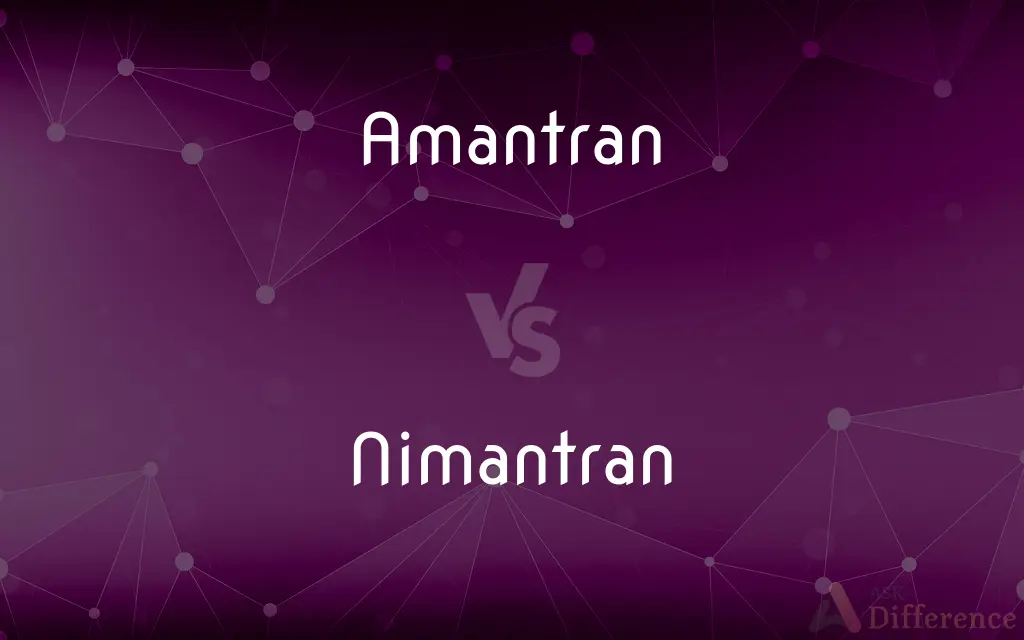Amantran vs. Nimantran — What's the Difference?
Edited by Tayyaba Rehman — By Fiza Rafique — Published on November 22, 2023
Amantran refers to a casual invitation, while Nimantran signifies a formal invitation. Both are Hindi terms representing different levels of inviting someone.

Difference Between Amantran and Nimantran
Table of Contents
ADVERTISEMENT
Key Differences
Amantran and Nimantran are both terms derived from Hindi, which pertain to the act of inviting. Amantran generally suggests a more casual, laid-back invitation. In contrast, Nimantran carries a tone of formality and is used for official or more serious events.
For everyday events or a simple get-together with friends, one might use the term Amantran. This contrasts with Nimantran, which would be more appropriate for ceremonies, official gatherings, or events where formalities are observed.
It's easy to see how cultural and societal norms shape the usage of Amantran and Nimantran. For instance, inviting a friend over for tea might be done with an Amantran, suggesting a relaxed atmosphere. However, a wedding invitation, with its inherent solemnity and ritual significance, would typically be a Nimantran.
The nuances between Amantran and Nimantran highlight the rich linguistic tapestry of Hindi. While both terms essentially mean to invite, the context, the gravity of the occasion, and the relationship between the inviter and invitee can dictate whether to use Amantran or Nimantran.
It's fascinating to note that even within the act of inviting, there exists a spectrum of formality. Amantran and Nimantran serve as linguistic tools to navigate this spectrum, ensuring that the nature of the invitation aligns with the event's tone and significance.
ADVERTISEMENT
Comparison Chart
Tone
Casual
Formal
Typical Usage
Everyday events, informal gatherings
Ceremonies, official events
Relationship Implication
Close friends, acquaintances
Distant relations, officials, broader audience
Linguistic Origin
Hindi
Hindi
Contextual Appropriateness
Relaxed, no strict adherence to protocols
Ritual significance, formality required
Compare with Definitions
Amantran
Amantran denotes an informal call to attend an event.
The Amantran for the weekend barbecue was extended to all friends in the neighborhood.
Nimantran
Nimantran is used for ceremonies or events with significant gravity.
The university extended a Nimantran to the alumni for its centennial celebrations.
Amantran
Amantran is more about a friendly gesture than a protocol.
His Amantran for a game night was always fun and spontaneous.
Nimantran
Nimantran signifies an invite with certain protocols or traditions.
The Nimantran for the inaugural event was printed on elegant cards.
Amantran
Amantran is typically used among close friends and acquaintances.
I received an Amantran to join them for a movie night.
Nimantran
Nimantran reflects respect and formality in the act of inviting.
We received a Nimantran to attend the international conference next month.
Amantran
Amantran represents a relaxed invite without many formalities.
There was an open Amantran for all to join the community picnic.
Nimantran
Nimantran stands for a formal, official invitation.
They sent a Nimantran for their daughter's wedding ceremony.
Amantran
Amantran is a laid-back, casual invitation.
She gave an Amantran to her neighbors for a spontaneous dinner.
Nimantran
Nimantran often indicates an event with a structured format.
The mayor's Nimantran for the town hall meeting was received by all residents.
Common Curiosities
Is Nimantran used for weddings?
Yes, weddings usually involve Nimantran because of the event's formality and significance.
Can I use Amantran for a friendly get-together?
Absolutely, Amantran is perfect for informal gatherings and casual events.
Can Amantran be used for official events?
Typically, Nimantran is preferred for official events due to its formal nature.
Which term, Amantran or Nimantran, is older in usage?
Both terms have deep roots in the Hindi language, but the exact age of usage is hard to determine.
What's a visual example of Nimantran?
A printed wedding invitation card is a classic example of Nimantran.
Are there any other terms similar to Amantran and Nimantran?
While Amantran and Nimantran are specific to levels of formality, there might be other regional terms or synonyms in Hindi with similar meanings.
Do all Hindi speakers understand the difference between Amantran and Nimantran?
Most Hindi speakers recognize the distinction in formality between the two terms.
Is Amantran more personal than Nimantran?
Generally, Amantran is seen as more personal and informal, suitable for closer relationships.
In what situations is Nimantran more appropriate?
Ceremonies, official gatherings, and events where formalities are observed are suited for Nimantran.
Can I use Nimantran for a casual tea invitation to a friend?
While you can, Amantran would be more fitting for such a casual invite.
What's the primary difference between Amantran and Nimantran?
Amantran is a casual invitation, while Nimantran is a formal invitation.
Can Amantran and Nimantran be used interchangeably?
While both mean "invitation," their usage depends on the event's formality. It's best to choose the term that matches the occasion's tone.
Is there a cultural significance to choosing Amantran or Nimantran?
Yes, the choice reflects the inviter's relationship with the invitee and the event's gravity in the cultural context.
How does the relationship between the inviter and invitee affect the choice of Amantran or Nimantran?
A closer relationship might warrant an Amantran, while a more distant or official relationship might lean towards Nimantran.
Are these terms unique to Hindi, or are they found in other languages too?
While the concepts of formal and informal invitations exist universally, the specific terms Amantran and Nimantran are rooted in Hindi.
Share Your Discovery

Previous Comparison
Carnal Sin vs. Original Sin
Next Comparison
Native vs. DomicileAuthor Spotlight
Written by
Fiza RafiqueFiza Rafique is a skilled content writer at AskDifference.com, where she meticulously refines and enhances written pieces. Drawing from her vast editorial expertise, Fiza ensures clarity, accuracy, and precision in every article. Passionate about language, she continually seeks to elevate the quality of content for readers worldwide.
Edited by
Tayyaba RehmanTayyaba Rehman is a distinguished writer, currently serving as a primary contributor to askdifference.com. As a researcher in semantics and etymology, Tayyaba's passion for the complexity of languages and their distinctions has found a perfect home on the platform. Tayyaba delves into the intricacies of language, distinguishing between commonly confused words and phrases, thereby providing clarity for readers worldwide.













































